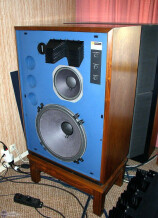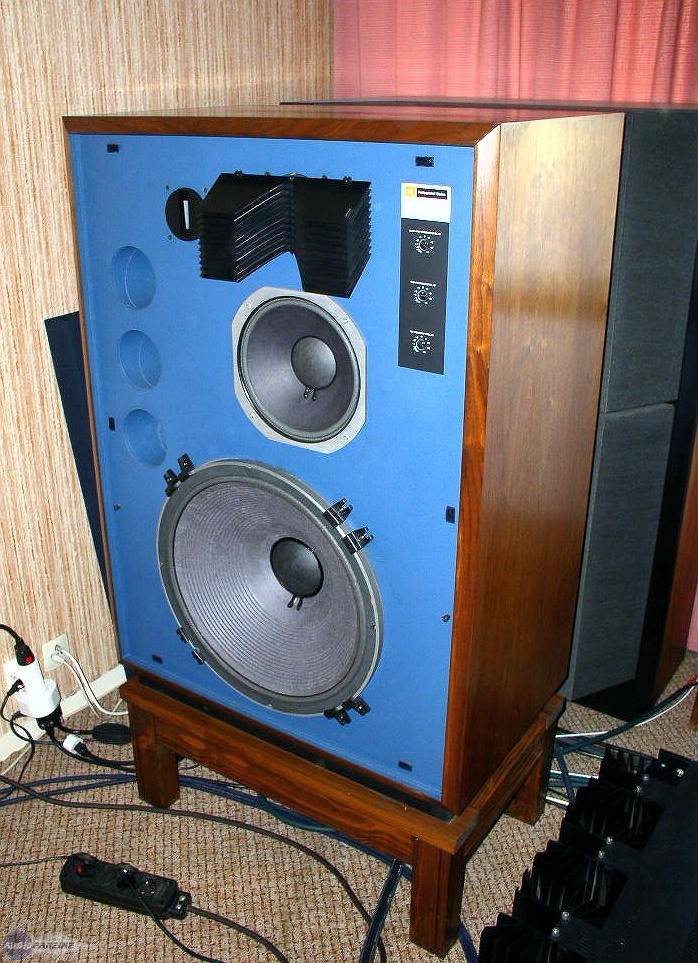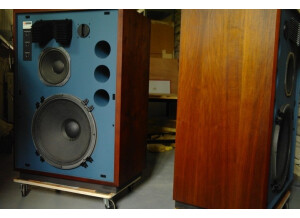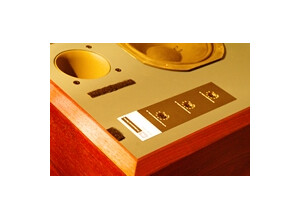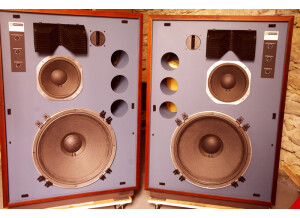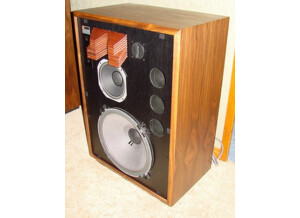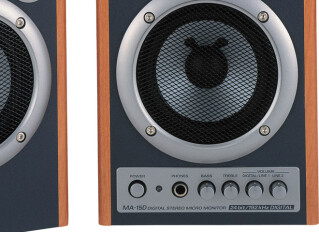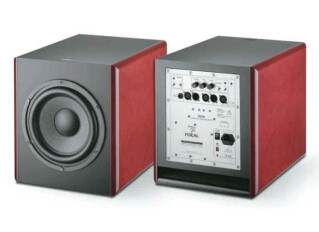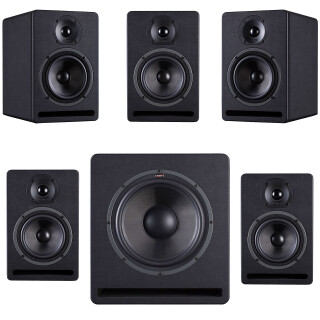Annonces 4345
Alerte nouvelle annonceImages
Avis
5.0/5(2 avis)
50 %
Donner un avis
Publié le 01/05/07 à 13:51
Bonjour, je ne possède pas ce modèle mais je me permet de poster ici l'avis et les conseils de mise en oeuvre de Greg Timbers (l'ingé qui les a concus), donnés en fevrier 2006 sur le forum audioheritage.org
http://www.audioheritage.org/vbulletin/showthread.php?p=110075#post110075
SONORITÉS
.
AVIS GLOBAL
I can't belive all the interest in this 30 year old system. It was never very successful during its life time primarily due to its size. Most people would get something smaller. It also had a reputation for less than detailed bass, which I have always thought was due to the enclosure not being quite large enough. I haven't thought about these things in years but since I have received...…
http://www.audioheritage.org/vbulletin/showthread.php?p=110075#post110075
SONORITÉS
.
AVIS GLOBAL
I can't belive all the interest in this 30 year old system. It was never very successful during its life time primarily due to its size. Most people would get something smaller. It also had a reputation for less than detailed bass, which I have always thought was due to the enclosure not being quite large enough. I haven't thought about these things in years but since I have received...…
Lire la suite
Bonjour, je ne possède pas ce modèle mais je me permet de poster ici l'avis et les conseils de mise en oeuvre de Greg Timbers (l'ingé qui les a concus), donnés en fevrier 2006 sur le forum audioheritage.org
http://www.audioheritage.org/vbulletin/showthread.php?p=110075#post110075
SONORITÉS
.
AVIS GLOBAL
I can't belive all the interest in this 30 year old system. It was never very successful during its life time primarily due to its size. Most people would get something smaller. It also had a reputation for less than detailed bass, which I have always thought was due to the enclosure not being quite large enough. I haven't thought about these things in years but since I have received a few requests for comments - here goes.
The system was and probably still is a stellar performer if you like the inherent sound of the traditional big JBL 4-ways. There is good news and bad news in the basic design. Good in that they are dynamic as hell and never get confused with intermodulation products of any type. They don't take much power to run and can swallow up a really big amp should you wish to do so. The weak areas of that type of design are several. First, there is a large time off-set between the 10" driver and the HL92 horn. This shows up in both the on-axis response, the directivity pattern and the homogeneity of the driver blending. The second problem is the use of a passive crossover between the top of the woofer and the bottom of the 10". Passive crossovers set to frequencies below about 500 Hz react badly with the motional impedance of the woofer/box combination and give substantial gain around 100 Hz. Gain out of a passive system is generally a bad thing. In the case of the High Pass, we have to work the passive network through a really large motional impedance peak resulting from the 10" fundamental resonance in the sub enclosure. This means that the actual voltage drive that occurs at the terminals of the 10" is less than ideal. There was the added complexity that the Marketing folks of that time required switchable bi-amp capabilities in which the incorrect setting of the switch was not allowed to hurt anything. These little things all add up to additional insertion loss for the woofer and loss of damping control. Now all of this sounds pertty bleak, but as you have no doubt noticed, no one told the 4345 that it can't work correctly so it does anyway.
My sonic memory of the big 4 ways, the last of which was the 4344MkII, is that they are effortless, dynamic, pretty low in coloration and really "alive". They are a little vague by today's standards in terms of precise imaging and although they are very low in intermodulation effects, they are not as detailed as really good lesser way designs. There is no simple answer to any of this and no one design statement that is best. Everything is a series of compromises, and the 4345 has a very good set of complimentary compromises.
I noticed a comment earlier in this string regarding the 2122H. It is a really good voice transducer. It always has been and always will be. Things just sound really natural through it. Another one that might be slightly better is the 2123. It is a little less smooth but perhaps a little more realistic on voice. Either are really good for that critical range from a few hundred Hz to about 1500 Hz.
I imagine you guys have talked about and tried lots of things to get the most out of the system. I will mention a few things that I would do if I had a pair at home for my primary system.
* Get rid of the bi-amp switch. Hardwire it in which ever mode you want it. The switch is not that great.
* If you can work out bi-amping do so. The difference in the 2245H and 2122H will be amazing. The crossover will have to be non standard. Neither driver is flat around crossover so the voltage drives will need to be adjusted to get proper acoustic bandpasses.
* The network components should be updated and this isn't easy. All the capacitors should be polypropylene and you would want to use air core inductors where ever possible. I believe the 4345 used some tapped iron cores. Those are hard to replace with aircores because the surrounding network topology would have to change and all of the values have to be re-engineered. I would suggest leaving them alone unless you are really good at this stuff.
* If you can swing it, go to a biased network. The difference is unbelievable.
* The ring radiator hates passive networks. A major improvement in the upper range would be to drive the 2405 from its own little amp. You only need 3 or 4 v rms. The 2405 does 110 dB for 2.83v. It is padded way down in the system. There is little real power at those frequencies anyway. You only need to know the voltage output of the amp, power is irrelevant. The 2405 is about 12 ohms and won't draw much current. I would use some little chip amp with a 2ond or 3rd order low level highpass in front of it. Take off the passive network to the ring and just feed it straight. Make sure the amp doesn't make a DC thump on turn on or turn off. That will fatigue the diaphragm. The amp will also have to have really low noise characteristics as any hiss will be really loud directly into the ring. I used to use an old Marantz 1030 integrated amp to run my rings. I could separate out the power amp section and the tweeters always sounded really good.
* The L-pads aren't so hot either, particularly after all of these years. Once you have your preferred balance, it is fairly easy to measure each leg of the L-pad and replace it with fixed resistors.
* I notice from many of the pictures that the system is elevated on blocks. It is very good to get the 2245 up off of the floor to minimize midbass fatness.
For resale reasons, you should be very careful about doing as much of this as possible reversibly.
Before closing I should comment briefly about the 250 - 4345 comparison. Simply put, I prefer a 250. I like the bass quality of the LE14 woofer. Alway have and always will. The 2245 when used as a dedicated sub is one of the best sounding woofers ever. It has an amazing blend of speed, pitch and punch. So does the 14" but the 18" is better. Unfortunately the 18" dislike for passive networks hurts it more than the 14" is hurt by a passive network. I think the mid and high range on the 250 is smoother and much more open however the 4345 wins by a bunch in terms of effortless dynamic sound. I have made all of the above changes to 250 systems (except for separate amp on UHF) and the improvement is huge. I have not done so on the 4345 but I suspect that that system will benefit from theses changes more than a 250 would. If both systems were tweaked out to about the same level, I suspect it would be very hard to come up with a clear overall winner, but I think I might lean towards the 4345 as having the greater potential.
Thank you all for the interest in my work. I must admit I have been blessed with a really nice profession that has treated me well for a very long time. Remember that sound and music enjoyment are very personal things and that what makes you happy may or may not please others. Screw them. If you are happy and no one is geting hurt then go for it. No loudspeaker system even approaches real life so there is plenty of room for interpretation.
http://www.audioheritage.org/vbulletin/showthread.php?p=110075#post110075
SONORITÉS
.
AVIS GLOBAL
I can't belive all the interest in this 30 year old system. It was never very successful during its life time primarily due to its size. Most people would get something smaller. It also had a reputation for less than detailed bass, which I have always thought was due to the enclosure not being quite large enough. I haven't thought about these things in years but since I have received a few requests for comments - here goes.
The system was and probably still is a stellar performer if you like the inherent sound of the traditional big JBL 4-ways. There is good news and bad news in the basic design. Good in that they are dynamic as hell and never get confused with intermodulation products of any type. They don't take much power to run and can swallow up a really big amp should you wish to do so. The weak areas of that type of design are several. First, there is a large time off-set between the 10" driver and the HL92 horn. This shows up in both the on-axis response, the directivity pattern and the homogeneity of the driver blending. The second problem is the use of a passive crossover between the top of the woofer and the bottom of the 10". Passive crossovers set to frequencies below about 500 Hz react badly with the motional impedance of the woofer/box combination and give substantial gain around 100 Hz. Gain out of a passive system is generally a bad thing. In the case of the High Pass, we have to work the passive network through a really large motional impedance peak resulting from the 10" fundamental resonance in the sub enclosure. This means that the actual voltage drive that occurs at the terminals of the 10" is less than ideal. There was the added complexity that the Marketing folks of that time required switchable bi-amp capabilities in which the incorrect setting of the switch was not allowed to hurt anything. These little things all add up to additional insertion loss for the woofer and loss of damping control. Now all of this sounds pertty bleak, but as you have no doubt noticed, no one told the 4345 that it can't work correctly so it does anyway.
My sonic memory of the big 4 ways, the last of which was the 4344MkII, is that they are effortless, dynamic, pretty low in coloration and really "alive". They are a little vague by today's standards in terms of precise imaging and although they are very low in intermodulation effects, they are not as detailed as really good lesser way designs. There is no simple answer to any of this and no one design statement that is best. Everything is a series of compromises, and the 4345 has a very good set of complimentary compromises.
I noticed a comment earlier in this string regarding the 2122H. It is a really good voice transducer. It always has been and always will be. Things just sound really natural through it. Another one that might be slightly better is the 2123. It is a little less smooth but perhaps a little more realistic on voice. Either are really good for that critical range from a few hundred Hz to about 1500 Hz.
I imagine you guys have talked about and tried lots of things to get the most out of the system. I will mention a few things that I would do if I had a pair at home for my primary system.
* Get rid of the bi-amp switch. Hardwire it in which ever mode you want it. The switch is not that great.
* If you can work out bi-amping do so. The difference in the 2245H and 2122H will be amazing. The crossover will have to be non standard. Neither driver is flat around crossover so the voltage drives will need to be adjusted to get proper acoustic bandpasses.
* The network components should be updated and this isn't easy. All the capacitors should be polypropylene and you would want to use air core inductors where ever possible. I believe the 4345 used some tapped iron cores. Those are hard to replace with aircores because the surrounding network topology would have to change and all of the values have to be re-engineered. I would suggest leaving them alone unless you are really good at this stuff.
* If you can swing it, go to a biased network. The difference is unbelievable.
* The ring radiator hates passive networks. A major improvement in the upper range would be to drive the 2405 from its own little amp. You only need 3 or 4 v rms. The 2405 does 110 dB for 2.83v. It is padded way down in the system. There is little real power at those frequencies anyway. You only need to know the voltage output of the amp, power is irrelevant. The 2405 is about 12 ohms and won't draw much current. I would use some little chip amp with a 2ond or 3rd order low level highpass in front of it. Take off the passive network to the ring and just feed it straight. Make sure the amp doesn't make a DC thump on turn on or turn off. That will fatigue the diaphragm. The amp will also have to have really low noise characteristics as any hiss will be really loud directly into the ring. I used to use an old Marantz 1030 integrated amp to run my rings. I could separate out the power amp section and the tweeters always sounded really good.
* The L-pads aren't so hot either, particularly after all of these years. Once you have your preferred balance, it is fairly easy to measure each leg of the L-pad and replace it with fixed resistors.
* I notice from many of the pictures that the system is elevated on blocks. It is very good to get the 2245 up off of the floor to minimize midbass fatness.
For resale reasons, you should be very careful about doing as much of this as possible reversibly.
Before closing I should comment briefly about the 250 - 4345 comparison. Simply put, I prefer a 250. I like the bass quality of the LE14 woofer. Alway have and always will. The 2245 when used as a dedicated sub is one of the best sounding woofers ever. It has an amazing blend of speed, pitch and punch. So does the 14" but the 18" is better. Unfortunately the 18" dislike for passive networks hurts it more than the 14" is hurt by a passive network. I think the mid and high range on the 250 is smoother and much more open however the 4345 wins by a bunch in terms of effortless dynamic sound. I have made all of the above changes to 250 systems (except for separate amp on UHF) and the improvement is huge. I have not done so on the 4345 but I suspect that that system will benefit from theses changes more than a 250 would. If both systems were tweaked out to about the same level, I suspect it would be very hard to come up with a clear overall winner, but I think I might lean towards the 4345 as having the greater potential.
Thank you all for the interest in my work. I must admit I have been blessed with a really nice profession that has treated me well for a very long time. Remember that sound and music enjoyment are very personal things and that what makes you happy may or may not please others. Screw them. If you are happy and no one is geting hurt then go for it. No loudspeaker system even approaches real life so there is plenty of room for interpretation.
Lire moins
51
»
Publié le 17/11/06 à 09:22
-puissance et rendement élevés semblant inépuisables en usage domestique même en étant très au delà des marges raisonnables...
-usage pro à l'origine, mixage des enregistrements, mais dans le salon ça va aussi!
-pour ma part bi-amplification transistors avec un gros classe A sur les voies supérieures.
belle bête! puissante, large bande passante, très définie, écoute inhabituelle, pouvant déranger pour une écoute d'ambiance, on décortique tout ce que comporte la source, mais biamplification indispensable, idéalement coupure à 290 hz à 24 db/octave, le filtre actif de la marque (M552) est parfaitement adapté, modèle appairé gauche/droite....
drogue dure après accoutumance.....la...…
-usage pro à l'origine, mixage des enregistrements, mais dans le salon ça va aussi!
-pour ma part bi-amplification transistors avec un gros classe A sur les voies supérieures.
belle bête! puissante, large bande passante, très définie, écoute inhabituelle, pouvant déranger pour une écoute d'ambiance, on décortique tout ce que comporte la source, mais biamplification indispensable, idéalement coupure à 290 hz à 24 db/octave, le filtre actif de la marque (M552) est parfaitement adapté, modèle appairé gauche/droite....
drogue dure après accoutumance.....la...…
Lire la suite
-puissance et rendement élevés semblant inépuisables en usage domestique même en étant très au delà des marges raisonnables...
-usage pro à l'origine, mixage des enregistrements, mais dans le salon ça va aussi!
-pour ma part bi-amplification transistors avec un gros classe A sur les voies supérieures.
belle bête! puissante, large bande passante, très définie, écoute inhabituelle, pouvant déranger pour une écoute d'ambiance, on décortique tout ce que comporte la source, mais biamplification indispensable, idéalement coupure à 290 hz à 24 db/octave, le filtre actif de la marque (M552) est parfaitement adapté, modèle appairé gauche/droite....
drogue dure après accoutumance.....la plupart des modèles hifi même THG semblera bien pâle et sans vie en comparaison...
SONORITÉS
-la courbe de réponse peut être délicate dans un local de faible dimension, mais en actif on peut maîtriser parfaitement le couplage avec la pièce, et au final, avec un peu de patience, mieux les optimiser qu'un modèle beaucoup moins encombrant...
-l'image est grandiose ( à condition de bien avoir les deux modèles gauche/droite)
-c'est clair, rapide, et ultra précis de haut en bas, et ça descend.....
-la dynamique réelle est ébourrifante (si les amplis suivent), comme en direct, ça peut déranger les habitués à l'écoute feutrée, ce modèle n'est pas conçu pour s'exprimer en sourdine....
AVIS GLOBAL
-Je les utilise depuis 22 ans
-ce que j'aime le plus: punch et définition
-ce que j'aime le moins: il faut de l'artillerie lourde en amont, et en biamplification, pour en tirer le meilleur parti
-rapport qualité/prix néanmoins très intéressant au vu des possibilités
-il faut être fou pour faire ce choix, mais c'est passionnant au vu des possibilités
-inconvénients:
-On a envie d'écouter à niveau réel, comme "en vrai", c'est bien pour une guitare séche ou pour un clavecin, mais pour le jazz ou le rock on peut aussi facilement terroriser son voisinage....
On n'a plus du tout envie de sortir à l'extérieur, c'est un idéal pour vivre en complète autarcie, comme un sauvage, et à peu près tout ce qu'on écoute ailleurs en reproduction "idiophile" prétentieuse, apparaît comme fade, sans vie, à des lustres de la musique en direct......C'est aussi un avantage car elles ne lassent pas et elles ont un potentiel d'exploitation absolument énorme, en fonction des moyens mis en oeuvre en amont, elles s'adapteront à toutes les situations, car le moindre peauffinage extérieur s'entend très nettement ( ex: le mariage avec les câbles de toutes sortes ).
Ce sont de véritables formules 1, tout ressort avec une acuité incomparable, ça oblige à TOUT maîtriser parfaitement, y compris les mariages avec les câbles secteurs alimentant les électroniques, car TOUT s'entend, mais en étant méthodique et précautionneux, au fil du temps, c'est un véritable plaisir d'optimiser très progressivement leur mise en oeuvre extérieure, car elles vous le rendent au centuple...leurs qualités semblent sans limites....
Un véritable plaisir de découvrir à tous les instants une palette aussi large d'informations, telle que désirée par les preneurs de son....Et pas seulement pour du rock, comme le croient certains à tort, les violons, l'orgue, la musique symphonique, médiévale, le clavecin, le piano, les instruments à cordes sont aussi un régal lorsque vous avez maîtrisé la mise en oeuvre....
Bref, de la drogue dure.....avec ses avantages ( nirvana très souvent atteint en bonne optimisation, illusion d'oubli total qu'il s'agit de musique enregistrée), et ses inconvénients ( dépendance totale et oubli de la vie courante et de ses contraintes basiques, comme simplement la bouffe....)
On ne pense plus qu'à elles, on ne vit plus que pour elles, on ne veut plus rien faire d'autre que d'écouter ses disques, on ne voit pas le temps passer, quand on est en vacances très loin, on regrette de ne pas pouvoir en profiter, et on s'ennuie d'elles, c'est encore pire qu'une maîtresse, etc...bref, pour tous ceux qui veulent tenter de rester "normaux", ne vous engagez pas dans ce genre de voie...Une fois atteint, c'est incurable....
-usage pro à l'origine, mixage des enregistrements, mais dans le salon ça va aussi!
-pour ma part bi-amplification transistors avec un gros classe A sur les voies supérieures.
belle bête! puissante, large bande passante, très définie, écoute inhabituelle, pouvant déranger pour une écoute d'ambiance, on décortique tout ce que comporte la source, mais biamplification indispensable, idéalement coupure à 290 hz à 24 db/octave, le filtre actif de la marque (M552) est parfaitement adapté, modèle appairé gauche/droite....
drogue dure après accoutumance.....la plupart des modèles hifi même THG semblera bien pâle et sans vie en comparaison...
SONORITÉS
-la courbe de réponse peut être délicate dans un local de faible dimension, mais en actif on peut maîtriser parfaitement le couplage avec la pièce, et au final, avec un peu de patience, mieux les optimiser qu'un modèle beaucoup moins encombrant...
-l'image est grandiose ( à condition de bien avoir les deux modèles gauche/droite)
-c'est clair, rapide, et ultra précis de haut en bas, et ça descend.....
-la dynamique réelle est ébourrifante (si les amplis suivent), comme en direct, ça peut déranger les habitués à l'écoute feutrée, ce modèle n'est pas conçu pour s'exprimer en sourdine....
AVIS GLOBAL
-Je les utilise depuis 22 ans
-ce que j'aime le plus: punch et définition
-ce que j'aime le moins: il faut de l'artillerie lourde en amont, et en biamplification, pour en tirer le meilleur parti
-rapport qualité/prix néanmoins très intéressant au vu des possibilités
-il faut être fou pour faire ce choix, mais c'est passionnant au vu des possibilités
-inconvénients:
-On a envie d'écouter à niveau réel, comme "en vrai", c'est bien pour une guitare séche ou pour un clavecin, mais pour le jazz ou le rock on peut aussi facilement terroriser son voisinage....
On n'a plus du tout envie de sortir à l'extérieur, c'est un idéal pour vivre en complète autarcie, comme un sauvage, et à peu près tout ce qu'on écoute ailleurs en reproduction "idiophile" prétentieuse, apparaît comme fade, sans vie, à des lustres de la musique en direct......C'est aussi un avantage car elles ne lassent pas et elles ont un potentiel d'exploitation absolument énorme, en fonction des moyens mis en oeuvre en amont, elles s'adapteront à toutes les situations, car le moindre peauffinage extérieur s'entend très nettement ( ex: le mariage avec les câbles de toutes sortes ).
Ce sont de véritables formules 1, tout ressort avec une acuité incomparable, ça oblige à TOUT maîtriser parfaitement, y compris les mariages avec les câbles secteurs alimentant les électroniques, car TOUT s'entend, mais en étant méthodique et précautionneux, au fil du temps, c'est un véritable plaisir d'optimiser très progressivement leur mise en oeuvre extérieure, car elles vous le rendent au centuple...leurs qualités semblent sans limites....
Un véritable plaisir de découvrir à tous les instants une palette aussi large d'informations, telle que désirée par les preneurs de son....Et pas seulement pour du rock, comme le croient certains à tort, les violons, l'orgue, la musique symphonique, médiévale, le clavecin, le piano, les instruments à cordes sont aussi un régal lorsque vous avez maîtrisé la mise en oeuvre....
Bref, de la drogue dure.....avec ses avantages ( nirvana très souvent atteint en bonne optimisation, illusion d'oubli total qu'il s'agit de musique enregistrée), et ses inconvénients ( dépendance totale et oubli de la vie courante et de ses contraintes basiques, comme simplement la bouffe....)
On ne pense plus qu'à elles, on ne vit plus que pour elles, on ne veut plus rien faire d'autre que d'écouter ses disques, on ne voit pas le temps passer, quand on est en vacances très loin, on regrette de ne pas pouvoir en profiter, et on s'ennuie d'elles, c'est encore pire qu'une maîtresse, etc...bref, pour tous ceux qui veulent tenter de rester "normaux", ne vous engagez pas dans ce genre de voie...Une fois atteint, c'est incurable....
Lire moins
102
»
Fiche technique
- Fabricant : JBL
- Modèle : 4345
- Catégorie : Enceintes de monitoring passives
- Fiche créée le : 04/08/2005
Nous n'avons pas de fiche technique sur ce produit
mais votre aide est la bienvenue
Distribué par Freevox
»


